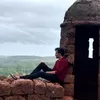Post
Thimpu Dzong
Paro Dzong
Tiger's Nest
Phuentsoling
Punakha Dzong
Dochula Pass
Bhumthang
Haa Valley
Check out the pages for the places. https://www.tripoto.com/trip/travel-diary-bhutan-a-reticent-realm-5be6ffb7b9c65 ; https://www.tripoto.com/trip/a-gem-at-the-neck-of-india-all-you-need-is-a-week-to-bask-bhutan-nearindia-5c3ec5ae06a50
1. Hiking
One thing tourists will notice when visiting Bhutan is its rich natural environment. Bhutan has always been mindful of the impact human activities have on the ecosystem. Guided by this value, human settlement in the urban and rural area offers close proximity to the nature. Tourists looking to rejuvenate can either spend quality time in the nature parks or go on a hike that offers drastic elevation experience and enjoy the vantage of the valley below.
Paro Taktsang Hike is the most popular hike in Bhutan. In this hike, tourists will visit a Buddhist monastery that is perched on a cliff 900 meters above Paro valley. First built in 17th century and its significance dating back to the 7th century, Paro Taktsang is one of the most sacred Buddhist site. The dirt trail from the base takes hikers through the pine forests and it takes 2 hours to reach the monastery. Upon arrival, tourists can marvel at the architectural accomplishment and the panoramic view of the valley below.
Read more on Paro Taktsang Hike
2. Experience Farm Stay
Spending a night or two at a farm house offers an authentic experience of the traditional Bhutanese way of life. The typical farm house is generally a two storied structure with traditional Bhutanese architectural aesthetics. These houses are generally seen in the rural areas where people’s primary occupation is agriculture and livestock. Tourists can spend the day observing and participate in the daily lives of these farmers leading a simple life. The experience also includes sharing traditional meals with the family, listening to their folk stories that was passed on for generations and taking a hot stone bath to unwind.
3. Explore Bhutanese Cuisine
Tourists can wake up to a cup of hot salted butter tea to warm themselves on a chilly morning. Traditional breakfast can be a plate of steamy red rice served with azay, a special condiment served with most Bhutanese dishes. Sikam (air dried pork belly) and shakam (sun dried beef) dishes cooked with assortment of vegetables and chilies are recommended for lunch and dinner.
Learn more about Bhutanese Cuisine
4. Cultural Sightseeing
Bhutan is regarded as a living monument because of its successful integration of ancient monuments into modern day Bhutan. With cultural preservation as one of its core development philosophy, Bhutan has many well preserved architectural heritages with rich and significant history. Tourists can explore and study the traditional Bhutanese arts and crafts that adorn the ancient monuments and understand its history and the evolution of roles it had played since its inception.
Read More: Top Attractions in Bhutan
5. Day Excursion to the Mountain Pass
The mountainous terrains in Bhutan have led to the construction of roads at unusually high elevation connecting different districts within Bhutan. With significant increase in elevation, the environment in terms of vegetation, climate and air are distinct at these mountain passes as compared to the valley. These mountain passes offer an amazing undisturbed and magnified view of the Eastern Himalayas. With the rising popularity of these destinations among the tourists, cafes and restaurants have been built to cater to the needs of the travelers.
Two most visited mountain passes are Dochula (3100m) and Chelela (3800m)
Read More: Dochula Pass Chelela Pass
6. Wildlife Safari
Almost 70% of Bhutan’s total land area is covered by forest and significant portion of it has been identified as national parks and wildlife sanctuaries spread across the country. In the southern central Panbang community, a home grown rafting company organizes wildlife expeditions for tourists interested in wildlife safari. Panbang community lies adjacent to the Royal Manas National Park which is home to the largest river basin and over 86 different mammals, 365 birds and 900 plant species. Its expedition includes rafting, jungle drives, walks and overnight stays at their jungle camp. Other such popular destinations include Phobjikha valley in the west and Merak Village (the land of the Yeti) in the east.
Show More





